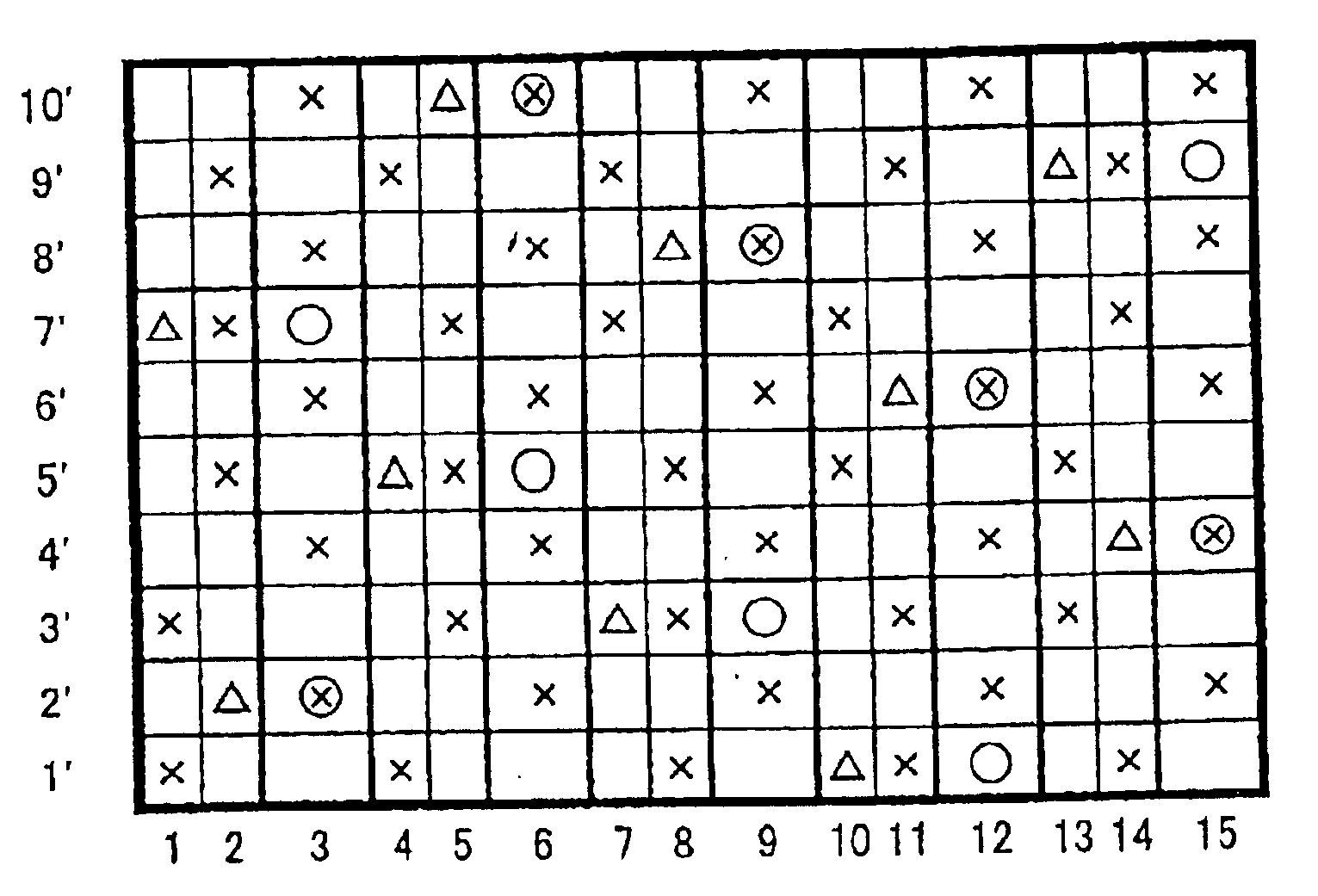Industrial multilayer textile
a multi-layer textile and textile technology, applied in the field of industrial textiles, can solve the problems of poor wet paper exfoliation in case of transferring wet paper to felt, further severe papering requirements, inferior wear resistance, etc., and achieve the effect of superior fiber supportability
- Summary
- Abstract
- Description
- Claims
- Application Information
AI Technical Summary
Benefits of technology
Problems solved by technology
Method used
Image
Examples
example 1
In the design view of FIG. 1, numerals 3, 6, 9, 12, and 15 denote upper surface side warps and running surface side warps that the upper surface side warps are disposed above the running surface side warps. Between the upper surface side warps and between running surface side warps, warp ground yarn connecting yarns are disposed in one set of two as 1 and 2, 4 and 5, 7 and 8, 10 and 11, and 13 and 14. Numerals with primes 1′, 2′, 3′, 4′, 5′, 6′, 7′, 8′, 9′, and 10′ denote wefts. Of these wefts, odd numbered upper surface side wefts 1′, 3′, 5′, 7′, and 9′ are first upper surface side wefts that pass under a warp ground yarn connecting yarn at a place shown with an x mark and do not pass under an upper surface side weft. Even numbered upper surface side wefts 2′, 4′, 6′, 8′, and 10′ are second upper surface side wefts that pass under an upper surface side warp at a place shown with an X mark and do not pass under a warp ground yarn connecting yarn. The upper surface side wefts are dis...
example 2
FIG. 3 showed another example of the present invention. The warp and weft of FIG. 3 are disposed in the same manner as those of Example 1, except for the one in which the order of one set of warp ground yarn connecting yarns is made alternate. In FIG. 1, the warp ground yarn connecting yarns in a pair of two different textures are present, each one of the warp ground yarn connecting yarns 1, 4, 7, 10 and 13 forms two knuckles on the upper layer surface (shown with marks of X), the other ones 2, 5, 8, 11 and 14 forms three knuckles (shown with marks of X), and those are disposed in the same order. However, in FIG. 3, the order of the first and second warp ground yarn connecting yarns are alternately changed or inversed, in that, first warp ground yarn connecting yarn of first pair forms two knuckles on the upper layer surface (e.g. the warp ground yarn connecting yarn 1) and second warp ground yarn connecting yarn of the first pair forms three knuckles (e.g. the warp ground yarn conn...
example 3
FIG. 4 is another example of the present invention. FIG. 4 is an 8-shaft two-layer textile, and the complete design view comprises four warps 3, 6, 9 and 12, and four sets of warp ground yarn connecting yarns 1 and 2, 4 and 5, 7 and 8, and 10 and 11. One set of two warp ground yarn connecting yarns is disposed between the warps. Examples 1 and 2 shown in FIGS. 1 and 3 have different textures of the warp ground yarn connecting yarns in one set. In the example 3, however, the textures of the warp ground yarn connecting yarns in one set are the same. On the textile surface, the texture of one set of two warp ground yarn connecting yarns forms a plain weave like one upper surface side warp. Concretely, the warp ground yarn connecting yarn 1 is in a texture in which it passes over one upper surface side weft 1′, passes between one upper surface side weft 2′ and the running surface side weft 2′, passes over one upper surface side weft 3′, passes between two upper surface side wefts 4′ and...
PUM
 Login to View More
Login to View More Abstract
Description
Claims
Application Information
 Login to View More
Login to View More - R&D
- Intellectual Property
- Life Sciences
- Materials
- Tech Scout
- Unparalleled Data Quality
- Higher Quality Content
- 60% Fewer Hallucinations
Browse by: Latest US Patents, China's latest patents, Technical Efficacy Thesaurus, Application Domain, Technology Topic, Popular Technical Reports.
© 2025 PatSnap. All rights reserved.Legal|Privacy policy|Modern Slavery Act Transparency Statement|Sitemap|About US| Contact US: help@patsnap.com



